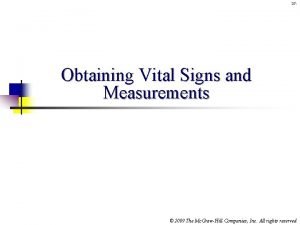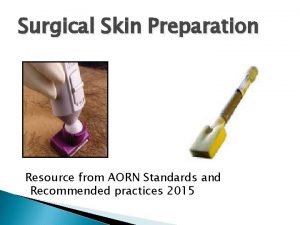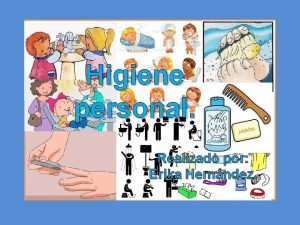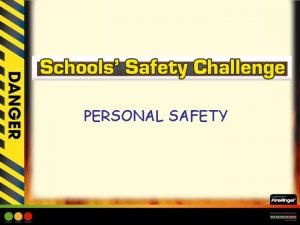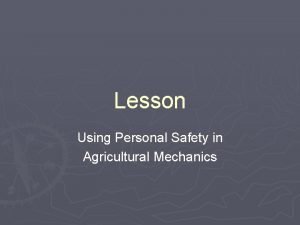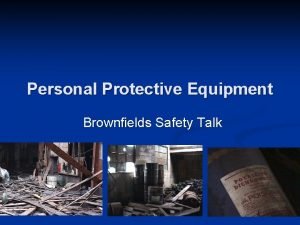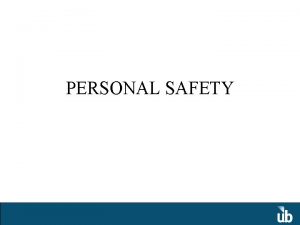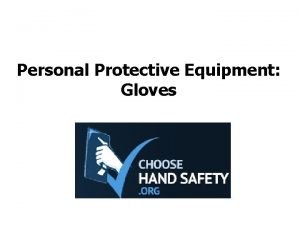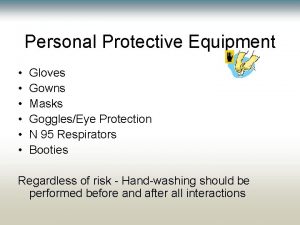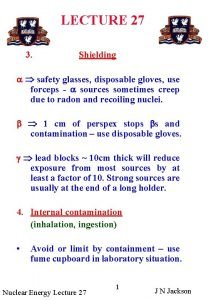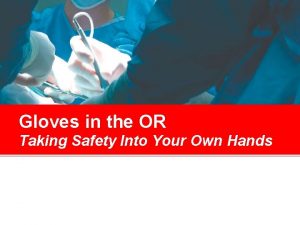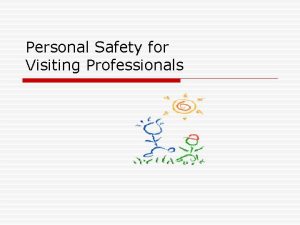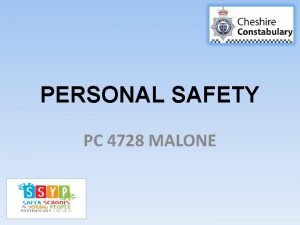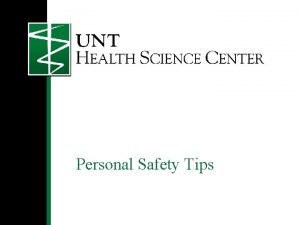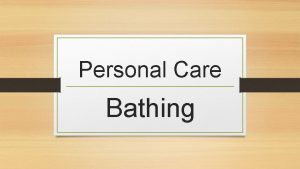Safety info session Gloves Safety info session Personal
































- Slides: 32

Safety info session - Gloves

Safety info session - Personal protective equipment • Collective protective equipment • Personal protective equipment (PPE) • Standard PPE in chemical lab: • Lab coat • Safety glasses • Other PPE according to risk assessment • Extra eye protection: laser/UV/… glasses, face screens, . . . • Hearing protection • Breathing protection: dust mask, half/full face mask, … • Hand protection: gloves, long sleeves, … • Body protection: apron, overall, … 2

Safety info session - PPE: Gloves • Gloves can protect to a variety of risks • Each requirement (chemical resistance, heat resistance, abrasion resistance, …) is represented by a symbol and a number stamped on the glove. • The higher the number, the higher level of protection. • The figures are derived from specific tests 3

Safety info session - PPE: Gloves • More info: https: //admin. kuleuven. be/sab/vgm/kuleuven/EN/ppe/intranet/reque sting-ppe • Instruction charts (for all PPE, incl gloves): https: //admin. kuleuven. be/sab/vgm/kuleuven/pbm/doc/PBMinstructi efiches. PS • • Their use or area of application. "Does not protect against …" A picture of the article. The technical specifications. Which standards have been assigned. Instructions for use example • Overview of all HSE approved gloves: overzicht • Work in progress, will be available soon 4

Safety info session - PPE: Gloves • Gloves = PPE = strict legal context • Advise from HSE department mandatory • Approval by safety committee (CPBW) mandatory • Contact HSE department if you need other gloves • All BIPP items labelled ‘approved’ are reviewed by HSE department 5

Content o Personnel protective equipment: gloves • protection from chemicals and microorganisms EN 374 28/11/2020 6

Gloves - Biological hazard • equipment • Focus on penetration: physical barrier o Water/air leak test • Indicated by AQL: Acceptable quality level o o o Statistical sampling method The lower the AQL, the more reliable the glove ‘Micro-organism’ pictogram: AQL <=1, 5 • Typical values: 1, 5 - 0, 65 – 0, 065 7

Gloves - Chemical Gloves • equipment 8

Gloves - Chemical Gloves • Collective protective equipment 9

Chemical Gloves – standard lab gloves vs specific gloves • Collective protective equipment • General practice: • Standard lab gloves will protect you against small splashes (for most chemicals) • Chemical on glove = replace glove • If higher exposure is expected/necessary: look for specific glove • Info found on gloves • PPE info (f. e. KUL instruction charts) • Breakthrough times for specific chemicals can be obtained at HSE department or at the supplier (f. e. info Kimtech), 10

Chemical Gloves- One time use @KU Leuven 11 Kimtech science comfort Nitril, 250 mm Kimtech science purple Nitril 250 mm Ansell Touchntuff 92 -605 Nitril, 300 mm Neotouch 25 -101 Neoprene 240 mm

How to order gloves: BIPP platform

Chemical Gloves- Reusable gloves @ KU Leuven Solvex 37 -675 Nitrile, 300 mm JKL AQL: 0, 65 13 Versatouch 62 -401 neopreen, 30 mm AKL AQL: 1, 5 Camatril 733 Nitrile 600 mm AJL AQL: 0, 65 Barrier PE/Nylon ABC AQL: 0, 065

How to order gloves: BIPP platform

Gloves- Reusable Chemical Gloves- good practices Taking care of chemical-resistant gloves o Inspect the gloves before put them on (cracks, tears, holes, swelling or other damage). If you spot any damage, discard the gloves. o Be sure the gloves you plan to wear are clean, never touch contaminated gloves with bare hands. o Wash your hands with soap and water before you put on the gloves. Bandage any minor cuts or scrapes. o Wash the outside of your gloves with water (and a mild detergent) before you remove them. Then thoroughly wash your hands. o Store gloves in a cool, dry place away from chemicals, don’t store your gloves inside out.

How to safely remove possibly contaminated gloves By the Safety & Health department, VIB 16

Step one With your gloved fingers, grab the outside of the other glove at the bottom of your palm

Step two Pull off your glove turning it inside out

Step three Grab the inside of the second glove at the wrist side with your bare fingers

Step four Pull off the second glove while turning it inside out Video

Content o Personnel protective equipment: gloves • Protection from mechanical risks 28/11/2020 21

Gloves- protection from mechanical risks Protection against mechanical hazards is expressed by a pictogram followed by four numbers (performance levels), each representing test performance against a specific hazard. • A = Abrasion resistance Based on the number of cycles required to abrade through the sample glove. • B = Blade cut resistance Based on the number of cycles required to cut through the sample at a constant speed. • C = Tear resistance Based on the amount of force required to tear the sample. • D = Puncture resistance Based on the amount of force required to pierce the sample with a standard-sized point. 22

Gloves- protection from mechanical risks 23

‘Mechanical’ Gloves- KULeuven 24

Content o o Introduction: Risk analyses general gloves • Protection from thermal hazards - heat 28/11/2020 25

Gloves- protection from Heat The nature and degree of protection is shown by a pictogram followed by a series of six performance levels, relating to specific protective qualities • a. Flammability resistance (0 to 4) Based on the length of time the material continues to burn and glow after the source of ignition is removed. The seams of the glove shall not come apart after an ignition time of 15 seconds. • b. Contact heat resistance (0 to 4) Based on the temperature range (100 -500 °C) at which the user will feel no pain for at least 15 seconds. 1 ≥ 100 °C 15 sec. 2 ≥ 250 °C 15 sec. 3 ≥ 350 °C 15 sec. 4 ≥ 500 °C 15 sec. • c. Convective heat resistance (0 to 4) Based on the length of time the glove is able to delay the transfer of heat from a flame. A level of performance shall only be mentioned if a performance level 3 or 4 is obtained in the flammability test. 26

Gloves- protection from heat • d. Radiant heat resistance (0 to 4) Based on the length of time the glove is able to delay the transfer of heat when exposed to a radiant heat source. A performance level shall only be mentioned if a performance level 3 or 4 is obtained in the flammability test. • e. Resistance to small splashes of molten metal (0 to 4) The number of molten metal drops required to heat the glove sample to a given level. A performance level shall only be mentioned if a performance level 3 or 4 is obtained in the flammability test. • f. Resistance to large quantities of molten metal (0 to 4) The weight of molten metal required to cause smoothing or pinholing across a simulated skin placed directly behind the glove sample. The test is failed if metal droplets remain stuck to the glove material or if the specimen ignites. 27

Heat resistant Gloves- KULeuven 28

Content o gloves • Protection from thermal hazards - cold 28/11/2020 29

Cold resistant Gloves- protection from Cold Protection against cold is expressed by a pictogram followed by a series of three performance levels, relating to specific protective qualities • A. Resistance to convective cold (0 to 4) Based on thermal insulation properties of the glove which are obtained by measuring the transfer of cold via convection. • B. Resistance to contact cold (0 to 4) Based on thermal resistance of the glove material when exposed to contact with a cold object. • C. Penetration by water (0 or 1) 0 = water penetration. 1 = no water penetration. . 30

Cold resistant Gloves- KULeuven 31

32
 Year up info session
Year up info session Your garden gloves case study answers
Your garden gloves case study answers Why do boxers wear gloves physics
Why do boxers wear gloves physics Poppies by jane weir
Poppies by jane weir Orthostatic vital signs
Orthostatic vital signs Tamara de lempicka young lady with gloves wikipedia
Tamara de lempicka young lady with gloves wikipedia Enable talk gloves
Enable talk gloves Sparse haptic proxy
Sparse haptic proxy Cloroprep
Cloroprep Sterile gloves
Sterile gloves Clear nitrile gloves
Clear nitrile gloves Sterile gloves
Sterile gloves Traditional part of speech
Traditional part of speech What is armour
What is armour Reflexive pronouns
Reflexive pronouns Class evidence vs individual evidence
Class evidence vs individual evidence Personal safety vs process safety
Personal safety vs process safety Example of portfolio development plan
Example of portfolio development plan Ace cpt promo code
Ace cpt promo code Formas no personales del verbo ejercicios
Formas no personales del verbo ejercicios Adivinanzas de higiene personal
Adivinanzas de higiene personal Bakit mahalagang magkaroon ng direksyon ang buhay
Bakit mahalagang magkaroon ng direksyon ang buhay Personal safety definition
Personal safety definition Unit 4 personal safety in agricultural mechanics
Unit 4 personal safety in agricultural mechanics Chapter 6 personal care skills
Chapter 6 personal care skills Personal protective equipment safety talk
Personal protective equipment safety talk Personal safety habits
Personal safety habits Catzoc ecdis definition
Catzoc ecdis definition Safety care certification
Safety care certification Ind safety report
Ind safety report Basic safety construction site safety orientation
Basic safety construction site safety orientation Basic safety construction site safety orientation
Basic safety construction site safety orientation Ratecompareresult.info
Ratecompareresult.info




